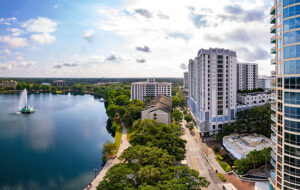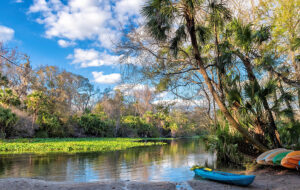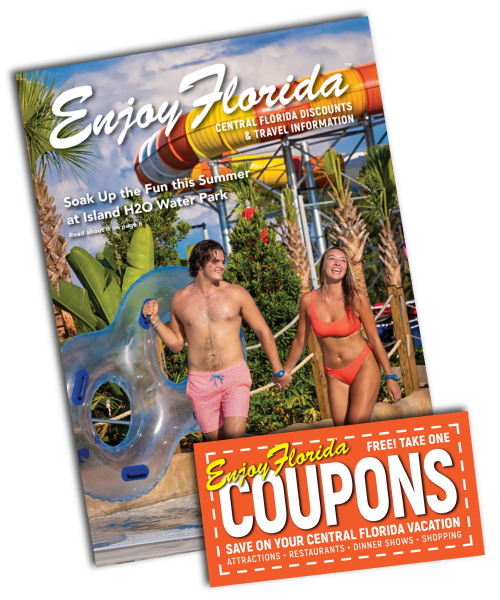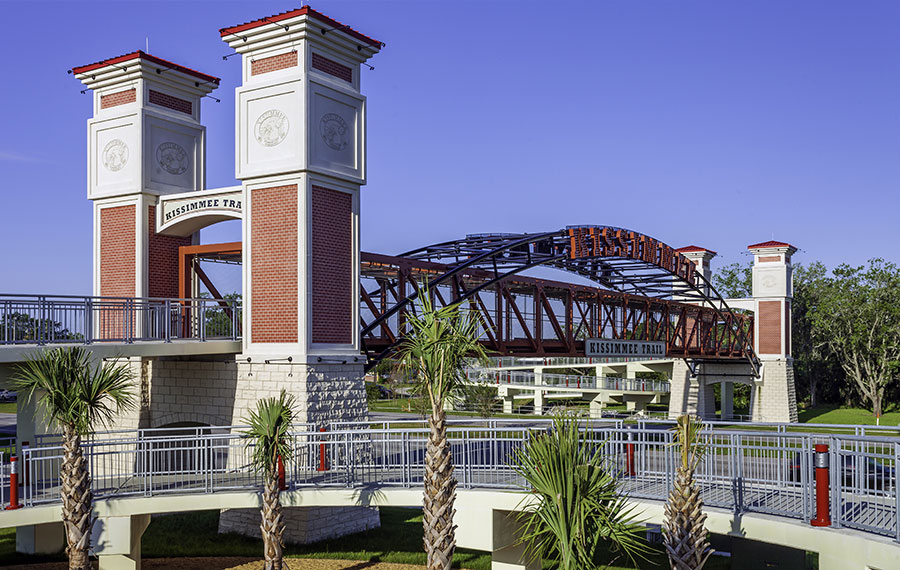
Nestled in the heart of Central Florida, Kissimmee is a charming city packed with history, quirky names, and unforgettable attractions. Whether you’re drawn to its roots as a cattle town, curious about the meaning behind its unique place names, or eager to explore its world-famous destinations, Kissimmee has a little bit of magic for everyone. From hidden gems to iconic landmarks, we’ve rounded up 25 fun facts that showcase what makes this vibrant city so special. Get ready to uncover the stories and surprises that make Kissimmee a must-visit treasure!
1) Old Town hosts the longest-running weekly car show in the country.
Every Saturday for the past 35 years, Old Town in Kissimmee has come alive with the roar of engines and the sparkle of vintage chrome. The Saturday Nite Classic Car Show and Cruise holds the title as America’s longest-running weekly car show, making it a cherished tradition for car enthusiasts and families alike. This iconic event attracts a diverse crowd, from collectors showcasing lovingly restored classics to curious visitors soaking up the nostalgia of yesteryear. Beyond the cars, it’s a community celebration, complete with live music and a timeless charm that captures the heart of Old Town. Whether you’re a gearhead or simply looking for a fun, family-friendly escape, the magic of this decades-old tradition is impossible to resist.
2) Kissimmee was once nicknamed “Kowtown” for its cattle industry roots.
During the 19th century, Kissimmee thrived as a hub for Florida’s booming cattle industry, where “cracker” cowboys (named for their method of driving cattle with cracking whips) worked the vast ranches throughout the Kissimmee River Valley. The city’s deep roots in ranching culture even inspired its affectionate nickname, “Kowtown.” This legacy is celebrated annually at the Kowtown Festival, held at Lakefront Park, where residents and visitors alike come together to honor Kissimmee’s rich history and vibrant community spirit on its birthday.
3) The iconic Orange World on Highway 192 withstood a somewhat magical attack in 2004.
Eli’s Orange World, with its iconic domed citrus roof, has been a steadfast roadside attraction since 1988, weathering nearly four decades of Florida’s unpredictable elements. But perhaps its most unique trouble came in 2004 during Hurricane Charley. Fierce winds slammed the nearby Giant Wizard gift shop, dislodging a massive crystal ball from its storefront sign. The enchanted orb hurtled through the wind and rain, colliding with Orange World’s roof and leaving a serious dent in its structure. Strangely, the crystal ball was never recovered, adding an eerie twist to the tale.
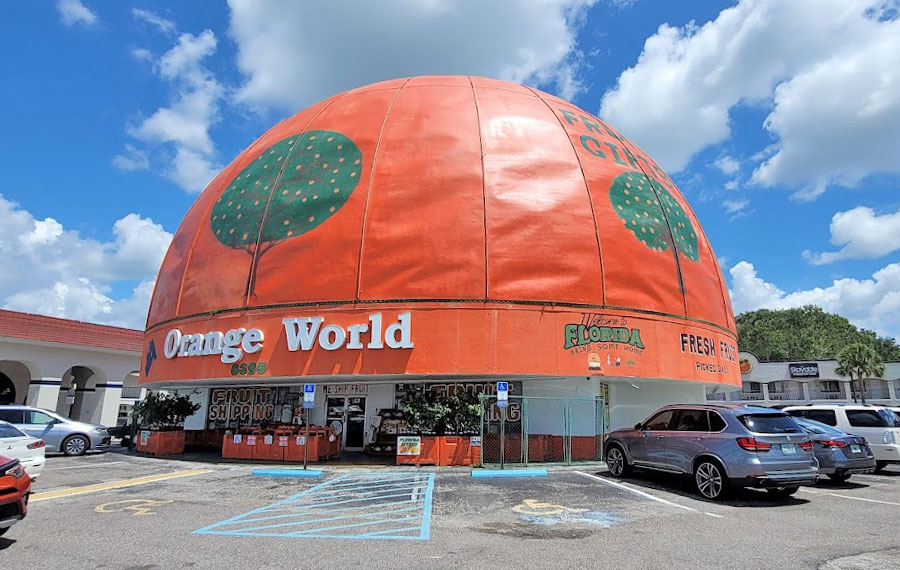
4) The Kissimmee Valley once served as the headwaters of the Florida Everglades.
Before the late-19th-century drainage project reshaped Florida’s natural landscape, the Kissimmee Valley was a vital ecological centerpiece, serving as the headwaters of the Florida Everglades as far north as Lake Tohopekaliga. This sprawling wetland system played a crucial role in maintaining the delicate balance of water flow, sustaining rich ecosystems teeming with wildlife. Seasonal flooding from the Kissimmee River connected the marshlands, allowing water to flow southward into the Everglades, creating a vast interconnected habitat renowned for its biodiversity. The drainage initiative, meant to prepare the land for agriculture and settlement, disrupted these natural processes, drastically altering the landscape and creating long-term environmental challenges. Understanding this historical connection underscores the importance of restoring and protecting Florida’s wetlands today.
5) Walt Disney World’s arrival sparked a huge change in the Kissimmee economy.
When Walt Disney World opened its gates in 1971 just outside of Kissimmee, it set off a wave of transformation that reshaped the small community. Before Disney arrived, Kissimmee was a quiet town with a population of just 1,120 residents. Within a decade of the park’s debut, the city experienced an astonishing growth, increasing to 15,490 people. The growth didn’t stop there. Today, Kissimmee’s population hovers around 80,000, as the area’s allure continues to attract new residents. Disney World not only put Kissimmee on the map but also established it as a thriving hub of tourism and development in Central Florida.
6) Hamilton Disston purchased 4 million acres of Kissimmee Valley land for only 25 cents an acre.
In 1881, real estate developer and industrialist Hamilton Disston made a monumental purchase that forever changed Florida’s landscape and history. For a mere 25 cents an acre, Disston acquired 4 million acres of land from the State of Florida, an area so vast it was larger than some U.S. states. Determined to transform the swampy wilderness of the Kissimmee River Valley into usable land, he embarked on an ambitious project, dredging canals and widening waterways to connect Lake Tohopekaliga to Lake Okeechobee 100 miles south. His efforts to drain the swamplands not only spurred development but also paved the way for agriculture and settlement in the region. Disston established his headquarters in a modest lakeside settlement called Allendale, which quickly became a hub of activity. By 1884, this once-small community was officially incorporated and renamed Kissimmee City. Disston’s vision and determination were pivotal in shaping the area, laying the foundation for Kissimmee’s transformation into the thriving city it is today.
7) Silver Spurs Rodeo got its start as a fundraiser for World War II.
On July 4, 1944, Kissimmee became home to a unique and patriotic event with the very first Silver Spurs Rodeo, held to support the war effort. Admission wasn’t just a ticket price, attendees had to purchase a war bond to gain entry, directly contributing to funding the nation’s military needs. This inventive approach not only entertained the local community but also united them in a shared sense of duty and support for their country during a challenging time in history. The rodeo’s legacy as a symbol of resilience and community spirit began with this meaningful act of collective contribution.
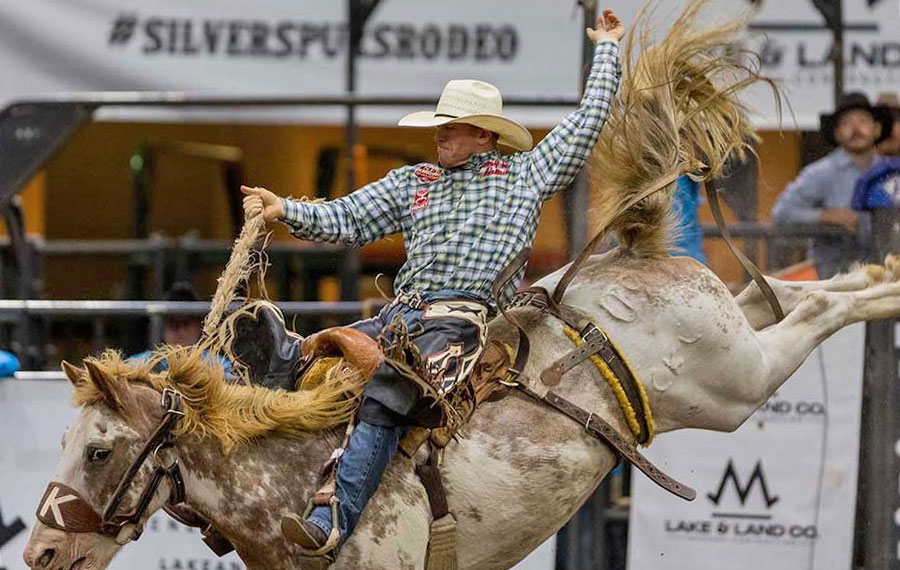
8) The Monument of States in Kissimmee was built entirely by volunteers.
The Monument of States, standing proudly on Monument Avenue in Downtown Kissimmee, is a striking tribute to unity and resilience. Completed by Dr. Charles W. Bressler-Pettis and J.C. Fisher, the monument was conceived during one of America’s darkest periods, in the aftermath of the attack on Pearl Harbor. Dr. Bressler-Pettis envisioned it as a powerful symbol of American solidarity, a beacon of hope to inspire unity across the nation. Built by dedicated volunteers, this unique structure is an extraordinary mosaic of diversity, featuring stones donated from every state in the U.S. and even from around the world. Its collection of materials serves as a testament to shared strength and global connection, with one especially notable contribution being a rock sent by President Franklin D. Roosevelt. Today, the Monument of States continues to stand as a reminder of the collaboration and perseverance that unite both communities and nations.
9) Kissimmee is known as the Vacation Home Capital of the World.
Kissimmee stands out as a premier vacation home destination, boasting the largest collection of vacation home rentals in the world, with over 50,000 options listed on platforms like Airbnb and Vrbo. Its enviable proximity to world-famous theme parks like Walt Disney World, Universal Orlando, and SeaWorld makes it an unmatched hub for travelers. The area offers an impressive selection of luxury-style homes, many equipped with private pools, game rooms, and located in gated communities offering high-end amenities. This makes it an ideal spot for visitors seeking both comfort and convenience. Renowned names like Encore Resort Homes at Reunion, The Bear’s Den Resort Orlando, Jeeves Florida Rentals, Magic Village Yards, Margaritaville Resort Orlando, and Magic Village Views Plus Vacation Homes elevate the experience, providing exceptional accommodations tailored to both relaxation and adventure. Whether you’re traveling with family, friends, or for a special event, Kissimmee’s vacation homes promise a memorable stay with easy access to world-class attractions.
10) Gatorland is home to the world’s only wheelchair accessible zip line ride.
Gatorland in Kissimmee is breaking barriers with its one-of-a-kind Gator Gauntlet, the world’s only wheelchair accessible zip line ride. Designed with inclusivity in mind, this thrilling attraction invites guests with mobility challenges or other disabilities to experience the same heart-pounding excitement as everyone else. Riders soar 350 feet through the air, gliding over scenic views of the park and the awe-inspiring lake of giant alligators below. It’s more than just a ride – it’s a moment of adventure, empowerment, and connection for everyone who participates.
11) Kissimmee is famous for its golfing culture.
Kissimmee is a golfer’s paradise with its impressive collection of 22 stunning 18-hole golf courses, offering something for players of all skill levels. Many of these courses boast designs from legends of the game, including Jack Nicklaus, Arnold Palmer, and Greg Norman, adding a touch of greatness to every round. Among them, Falcon’s Fire Golf Club stands out as a premier destination near Disney property, known for its immaculate greens and top-notch facilities. Beyond the variety of courses, it’s the year-round warm, sunny weather that truly sets Kissimmee apart, making it the perfect destination for golfers looking to hit the greens no matter the season.
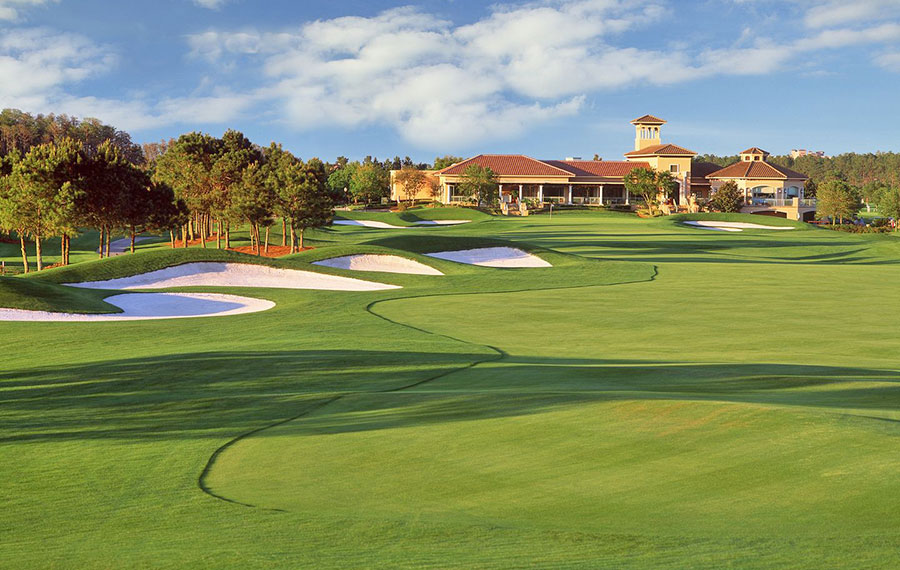
12) In the late-19th century, Kissimmee became a trade route hub for steamboats and trains.
The settlement of Allendale, later known as Kissimmee City, played a pivotal role in Central Florida’s transportation and trade during the 1880s. Acting as a bustling port, it became a key hub for steamboats navigating the waters between Lake Tohopekaliga and Lake Okeechobee, facilitating commerce in the region. However, the arrival of railway lines in 1882 marked the beginning of a major transformation. Trains extended routes south from Sanford, offering a faster, more efficient alternative to riverboat travel. By 1885, the reliability and speed of railroads had surpassed the functionality of steamboats, cementing their place as the dominant mode of transportation and reshaping Kissimmee’s role in Florida’s growing infrastructure. This shift not only ended the era of steamboat travel but also ushered in a new chapter of economic and industrial growth.
13) Celebration was originally a master-planned community developed by The Walt Disney Company.
The town of Celebration is a charming spot created by The Walt Disney Company in the 1990s as a master-planned community that reflects the nostalgia of small-town America. Designed with careful attention to detail, Celebration features picturesque streets lined with pastel-colored homes, front porches, and a mix of architectural styles like Colonial, Victorian, and Mediterranean. Its walkable downtown offers boutique shops, cozy cafes, and a scenic lakefront, making it a delightful spot for both residents and visitors. Tourists are drawn to its year-round community events, including holiday celebrations and farmers markets, which add a lively atmosphere to the serene setting. Just minutes away from Kissimmee’s Highway 192, Celebration blends a storybook aesthetic with modern convenience, making it a unique and memorable destination.
14) Shingle Creek was one of the first settlements in the Kissimmee Valley.
The roots of Kissimmee’s history can be traced back to Shingle Creek, where the first settlement in the area emerged. Located along a military route used during the Seminole Wars, this location connected Sanford to Tampa, highlighting its critical role in Florida’s early development. Shingle Creek took its name from a unique and practical operation that defined the settlement’s livelihood. A sawmill in the area used the abundant cypress trees to produce wooden shingles, a vital material for building and roofing at the time. This combination of natural resources and historical significance paints a vivid picture of Shingle Creek as both a vital hub for frontier life and a testament to the resilience of early settlers in shaping the region’s identity.
15) Narcoossee, one of the area’s first settlements, means “little bear” in the Seminole language.
Nestled in the heart of the Kissimmee Valley, the settlement of Narcoossee boasts a rich history that connects its Seminole roots and British heritage. The name “Narcoossee,” meaning “little bear” in the Seminole tongue, hints at its deep connection to the region’s native culture. Established as one of the area’s oldest settlements, it became a unique melting pot when British immigrants arrived, bringing with them their traditions, including an abiding passion for polo. This influence quickly shaped the community, establishing Narcoossee as a hub for the sport. By 1888, the settlers had organized a polo team that thrived. Within just two years, the team swelled to more than 100 members, demonstrating not only the growing popularity of polo but also the settlers’ ability to foster a shared sense of identity and recreation in their new homeland. This rapid rise of polo in Narcoossee speaks volumes about the dynamic cultural blend and spirit of the settlement.
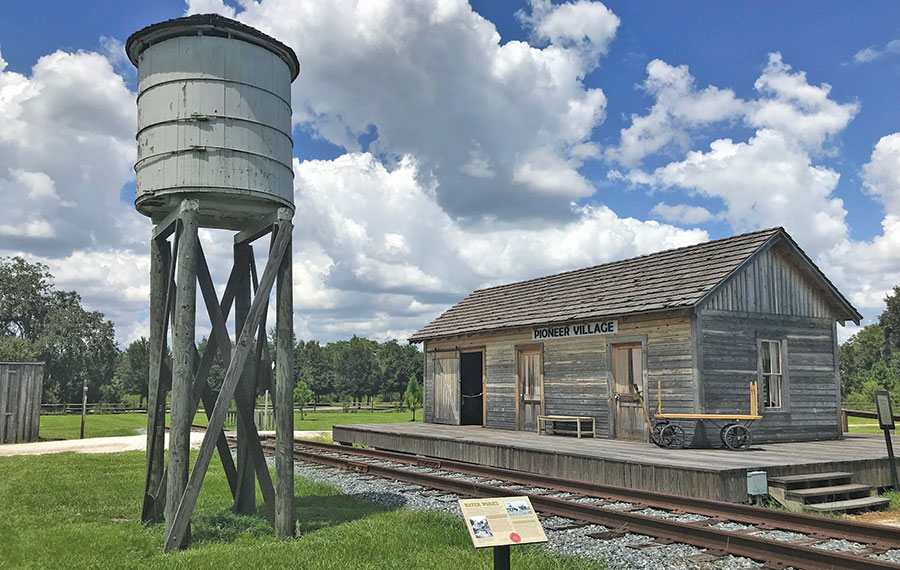
16) The buildings at Pioneer Village were relocated from different areas of Osceola County.
Pioneer Village is a remarkable window into Kissimmee’s storied past, offering visitors a glimpse of what life was like before modern conveniences reshaped the region. This unique historical site is composed of authentic structures carefully relocated from various parts of the county, each meticulously preserved to retain their original charm and significance. The village boasts an impressive variety of buildings, including a general store and post office, a one-room schoolhouse, a quaint church, and a historic train depot. Visitors can also explore homesteads once inhabited by Osceola settlers, gain insight into the lives of Seminole communities through a recreated settlement, and experience a slice of early Floridian life at an authentic cow camp. For a deeper look into the area’s working history, the village features structures like a blacksmith shop, citrus packing plant, cane grinder, and barn. Together, these preserved landmarks create a vibrant tapestry of Kissimmee’s heritage, blending education and nostalgia in an unforgettable experience.
17) The name Kissimmee means “long water.”
The name Kissimmee carries a fascinating piece of history, rooted in the culture of the native Jororo people. This indigenous group, who once inhabited the region, gave the area its name, which translates to “long water.” The meaning perfectly reflects the area’s connection to the Kissimmee River, a vital waterway that shaped the land and supported life for centuries. While much about the Jororo people remains a mystery today, their legacy lives on through the name Kissimmee, offering a glimpse into the deep ties between the landscape and the people who first called it home.
18) Kissimmee’s Osceola County is named in honor of the Seminole leader Chief Osceola.
Osceola County derives its name from the legendary figure Chief Osceola, originally born as Billy Powell in Alabama in 1804. A mixed-race warrior of Creek and Scottish descent, he became a prominent leader among the Seminole people during the tumultuous 1830s. At the age of 16, he adopted the name Osceola, meaning “black drink crier,” during a tribal ceremony, symbolizing his connection to Seminole traditions. Though not officially a chief, Osceola earned widespread respect for his leadership and resistance against the U.S. Army during the Second Seminole War. His life was tragically cut short in 1838 when he died in captivity at Fort Moultrie, South Carolina, but his legacy endures as a symbol of resilience and Native American rights.
19) Kissimmee was originally name Allendale after a steamboat captain.
Before it became the city we know today as Kissimmee, the small settlement on Lake Tohopekaliga went by the name Allendale. This original name honored Civil War Confederate Major J.H. Allen, a notable figure in the region’s early history. Major Allen played a significant role in local commerce, operating a cargo steamboat along the Kissimmee River, which was a vital transportation route for goods and supplies during that time. The river’s importance as a trade artery helped shape the development of the settlement, and the name Allendale reflected Allen’s influence on the community’s beginnings.
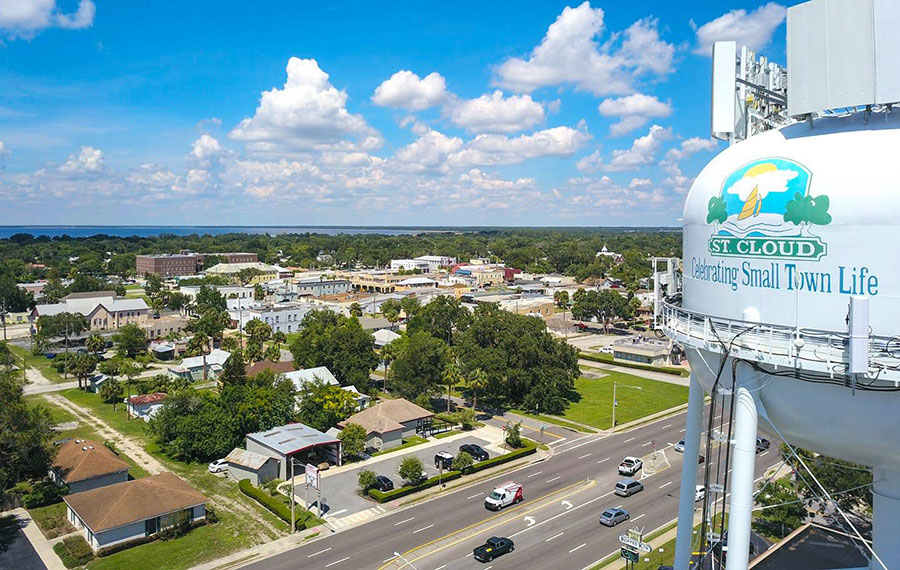
20) St. Cloud was founded as a postwar settlement for Civil War Union veterans.
St. Cloud, neighboring city to Kissimmee, was founded on April 16, 1909, with a unique vision as a retirement community for Union veterans of the Civil War. These veterans, often referred to as “The Grand Army of the Republic,” were offered the opportunity to purchase five-acre lots for just $50 each. This forward-thinking initiative not only provided the veterans with affordable land but also laid the foundation for a growing community. St. Cloud’s history as the “Soldier City” continues to shape its identity and charm today.
21) The area settlement of Kenansville was named after Henry Flagler’s wife Mary Lily Kenan.
Kenansville, a small settlement in the Kissimmee Valley, owes its name to the generosity and influence of the famed railroad tycoon Henry Flagler. Known for his transformative contributions to Florida’s development, Flagler played a pivotal role in the community by donating land and funds to establish a local schoolhouse. To honor his wife, Mary Lily Kenan, he named the settlement Kenansville. This act of naming not only reflected his personal affection but also left a legacy tied to the Kenan family name, forever embedding it in the history of the region.
22) Since 1971, Walt Disney World estimates that 1.65 million pairs of sunglasses have ended up in lost and found.
Disney World’s lost and found department is a bustling hub of forgotten treasures, reflecting the sheer number of guests that pass through its gates. Since 1971, an astounding 1.65 million pairs of sunglasses have been handed in, with more than 200 pairs misplaced each day. Every year, the department collects over 6,000 cell phones, 3,500 digital cameras, and a staggering 18,000 hats. To ensure these items find a new purpose, Disney World holds onto them for about three months before donating the unclaimed to charities such as the Boys & Girls Club of Central Florida. Their system not only helps reunite visitors with their lost belongings but also supports the local community in meaningful ways.
23) Kissimmee’s Medieval Times Dinner Show was the first one to open in North America.
Medieval Times Dinner & Tournament debuted in Kissimmee in December 1983 for the first time in North America, marking the start of a unique, immersive entertainment experience that has since become iconic. Its opening not only brought an innovative blend of dining and live-action medieval-themed performances to the U.S., but it also cemented Kissimmee’s reputation as an entertainment hotspot near Orlando’s thriving attractions. This pioneering venture drew visitors from across the nation, offering a memorable experience filled with jousting knights, dazzling horsemanship, and four-course feasts. Over the years, it has significantly contributed to the area’s tourism economy, becoming a staple for families and visitors seeking a blend of excitement and history.
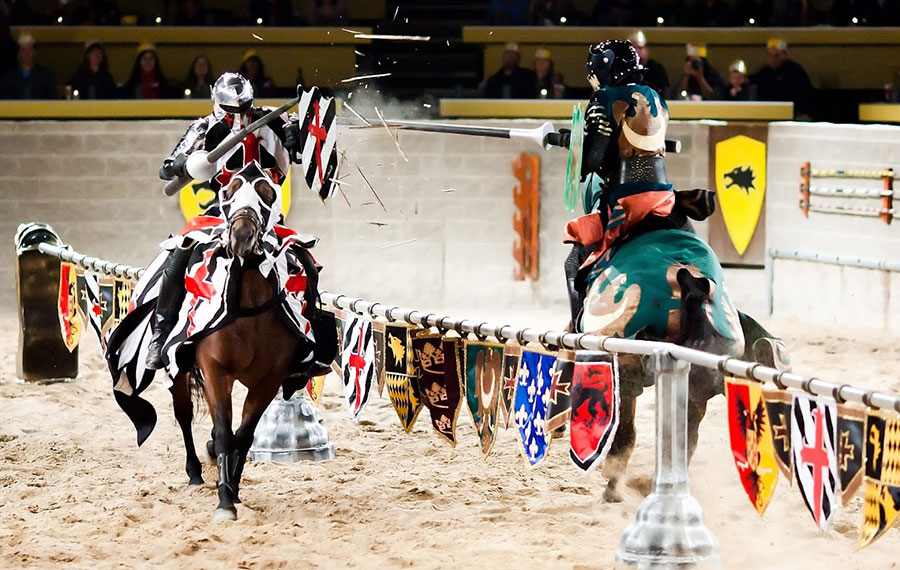
24) Central Florida’s most anticipated holiday event is “Now Snowing” in Celebration.
Celebration Town Center’s “Now Snowing” event transforms Central Florida into a magical Winter Wonderland, captivating visitors with its festive charm and family-friendly appeal. Running from Thanksgiving through the end of December, this extravaganza features nightly snowfall, bringing a touch of traditional holiday magic to the Sunshine State. Unique attractions like one of the area’s only synthetic ice rinks and horse-drawn carriage rides add to the seasonal fun, making it a favorite for both locals and visitors. Families can enjoy strolling Charles Dickens-style carolers, snap memorable photos with Santa, and even hop aboard train rides through the twinkling town center. With special performances by talented young artists and live concerts, “Now Snowing” offers an unforgettable holiday experience that blends classic traditions with Celebration’s signature flair.
25) Gatorland was Central Florida’s first theme park.
Gatorland holds a special place in Central Florida’s history as its first-ever theme park, offering visitors a unique glimpse into the allure of Florida’s wild side long before the glittering lights of modern attractions took over. Founded in 1949 by Owen Godwin, this rugged park quickly became a must-see destination, drawing crowds with its fascinating wildlife and thrilling exhibits. Its centerpiece and first major attraction was a jaw-dropping 15-foot crocodile, rumored to be the largest in the world at the time. This colossal reptile captured the imagination of guests, setting the tone for Gatorland’s reputation as the go-to spot for up-close encounters with nature’s fiercest creatures. Decades later, Gatorland remains a beloved landmark, blending old Florida charm with unforgettable adventures.
From its rich history and charming place names to its must-see attractions, Kissimmee is bursting with wonder and surprises. Whether you’ve uncovered a new piece of its past or added a few spots to your travel bucket list, we hope these fun facts have sparked your curiosity. But don’t stop here! Check out our Kissimmee Vacation Guide for more tips, hidden gems, and must-visit destinations. Kissimmee isn’t just a gateway to theme park adventure – it’s an adventure all its own. Plan your visit and experience firsthand what makes this vibrant city unforgettable.

